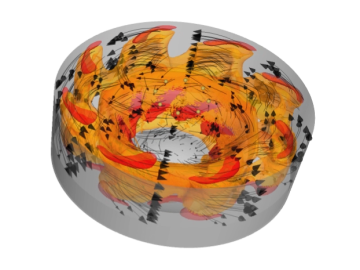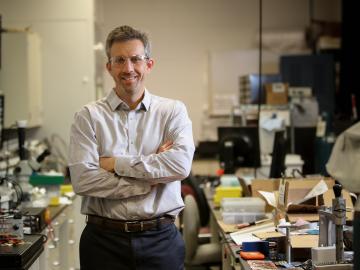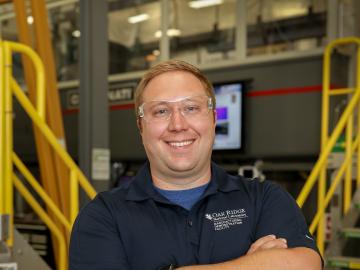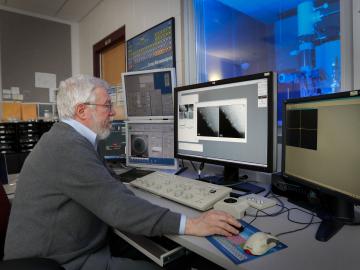
Filter News
Area of Research
- Advanced Manufacturing (5)
- Biological Systems (1)
- Biology and Environment (103)
- Biology and Soft Matter (4)
- Building Technologies (2)
- Chemical and Engineering Materials (3)
- Chemistry and Physics at Interfaces (7)
- Clean Energy (187)
- Climate and Environmental Systems (7)
- Computational Biology (1)
- Computational Chemistry (5)
- Computational Engineering (1)
- Computer Science (3)
- Data (1)
- Earth Sciences (1)
- Electricity and Smart Grid (1)
- Energy Frontier Research Centers (7)
- Fuel Cycle Science and Technology (2)
- Functional Materials for Energy (8)
- Fusion and Fission (33)
- Fusion Energy (7)
- Geographic Information Science and Technology (1)
- Isotope Development and Production (1)
- Isotopes (22)
- Materials (136)
- Materials for Computing (13)
- Materials Synthesis from Atoms to Systems (8)
- Materials Under Extremes (7)
- National Security (46)
- Neutron Data Analysis and Visualization (2)
- Neutron Science (74)
- Nuclear Science and Technology (29)
- Quantum Condensed Matter (3)
- Quantum information Science (4)
- Renewable Energy (2)
- Sensors and Controls (2)
- Supercomputing (155)
- Transportation Systems (4)
News Type
News Topics
- 3-D Printing/Advanced Manufacturing (44)
- Advanced Reactors (9)
- Artificial Intelligence (47)
- Big Data (27)
- Bioenergy (52)
- Biology (60)
- Biomedical (29)
- Biotechnology (12)
- Buildings (24)
- Chemical Sciences (26)
- Clean Water (15)
- Climate Change (54)
- Composites (7)
- Computer Science (89)
- Coronavirus (18)
- Critical Materials (3)
- Cybersecurity (14)
- Decarbonization (50)
- Education (1)
- Emergency (2)
- Energy Storage (35)
- Environment (110)
- Exascale Computing (26)
- Fossil Energy (4)
- Frontier (25)
- Fusion (33)
- Grid (25)
- High-Performance Computing (44)
- Hydropower (5)
- Isotopes (28)
- ITER (2)
- Machine Learning (23)
- Materials (44)
- Materials Science (54)
- Mathematics (7)
- Mercury (7)
- Microelectronics (2)
- Microscopy (23)
- Molten Salt (1)
- Nanotechnology (20)
- National Security (40)
- Net Zero (8)
- Neutron Science (50)
- Nuclear Energy (60)
- Partnerships (16)
- Physics (34)
- Polymers (11)
- Quantum Computing (21)
- Quantum Science (31)
- Renewable Energy (1)
- Security (12)
- Simulation (32)
- Software (1)
- Space Exploration (12)
- Statistics (1)
- Summit (30)
- Sustainable Energy (48)
- Transformational Challenge Reactor (3)
- Transportation (32)
Media Contacts


Most car owners in the United States do not think twice about passing over the diesel pump at the gas station. Instead, diesel fuel mostly powers our shipping trucks, boats, buses, and generators—and that is because diesel engines are about 10 percent more fuel-efficient than gaso...

Nuclear physicists are using the nation’s most powerful supercomputer, Titan, at the Oak Ridge Leadership Computing Facility to study particle interactions important to energy production in the Sun and stars and to propel the search for new physics discoveries Direct calculatio...

Yarom Polsky’s diverse background in private and public-sector research has given him a knack for recognizing opportunities to advance the state-of-the-art, and he parlays that knowledge into successful innovation as an engineer, group leader, and

Brian Post came to the Department of Energy's Oak Ridge National Laboratory looking for a way to combine his interests in controls engineering and robotics, and he found it at the Manufacturing Demonstration Facility (MDF), where he and his colleagues are revolutionizing 3D-printi...

At the Department of Energy’s Oak Ridge National Laboratory, Olufemi “Femi” Omitaomu is leveraging Big Data for urban resilience, helping growing cities support future infrastructure and resource needs. A senior research scientist for ORNL’s Computational Sciences and Engineeri...

Material surfaces and interfaces may appear flat and void of texture to the naked eye, but a view from the nanoscale reveals an intricate tapestry of atomic patterns that control the reactions between the material and its environment. Electron microscopy allows researchers to probe...

Some engineers are attracted to fuels and engine research out of a love of cars. For Robert Wagner, however, enthusiasm for combustion science and chaos theory drew him to this area of research at Oak Ridge National Laboratory. After years of delivering breakthroughs for cleane...



